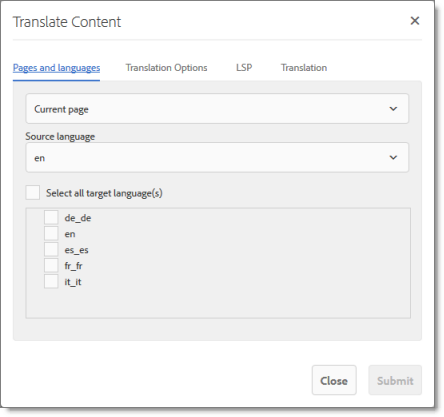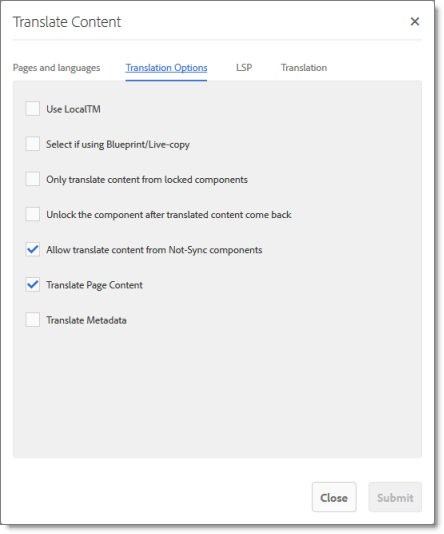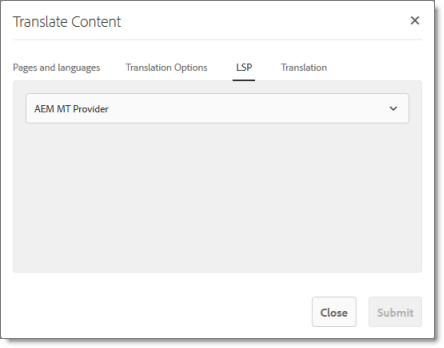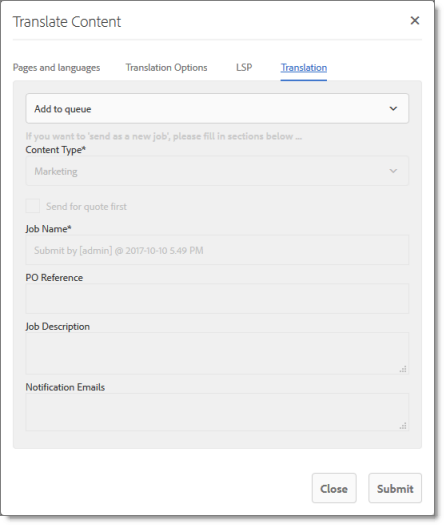Sending Pages for Translation from the Touch-Optimized UI (Adobe Experience Manager version 6.3 and higher only)
10 minute read
If you are using Adobe Experience Manager version 6.3 or higher, you can send pages for translation or to the Translation Queue directly from the Touch-Optimized UI.
Tip: This method is ideal for ad-hoc translations or for sending small amounts of content for translation.
Note: Depending on your user permissions or your company configuration, you may not be able to send out content directly for translation.
Note: If one or more paths are configured for your team profile, you can send only pages that are in those paths for translation.
To send pages for translation from the Touch-Optimized UI:
-
In the Adobe Experience Manager Touch-Optimized UI, navigate to one of the following pages:
- the page you want to send for translation
- the parent page of sub pages you want to send for translation
-
Select the Edit mode. For detailed instructions, refer to the Adobe Experience Manager documentation, “Editing Page Content” which is available at: https://docs.adobe.com/docs/en/aem/6-3/author/page-authoring/editing-content.html.
-
In the top-left corner, click the Page Information icon
 .
. -
In the menu that opens, click Translate Content, which is the second-to-last menu option.
The Pages and languages tab of the Translate Content wizard opens.

- In this tab, you choose the following settings:
| Setting | Description |
|---|---|
| which pages to translate | By default, Current page is selected, which sends only the current page for translation. Alternatively, you can select one of the following options from the dropdown menu: * All sub pages: The Connector sends all sub pages of the current page for translation. It does not send the current page for translation. * Current page and all sub pages: The Connector sends the current page and all sub pages of the current page for translation. |
| Source language | Select the source language for translation. The Connector will send pages in this source language for translation. |
| Select all target language(s) | Select the check boxes for all the target languages into which you want to translate the source content. The list displays all the languages that are set up in Adobe Experience Manager for your team. To select all available languages, select the Select all target language(s) check box, above the list of languages. |
- Click the Translation Options tab.

In this tab, you specify the following translation options:
Note: Your company’s configuration determines the default value of each option.
| Option | Description |
|---|---|
| Use Local TM | This feature determines whether to check each component in the source version of the item for any content changes, and send only changed components out for translation. If a component was previously translated and it has not changed, then the Connector does not send it for translation again: Instead, it uses the stored translation. This feature reduces the quantity of content that the Connector sends to translation providers, which reduces your cost. However, it needs the Connector translation backup data, and it increases the Connector processing time before sending out the items for translation. If this check box is selected, the Connector checks whether content was already translated before sending it out for translation. If this check box is cleared, the Connector sends out content for translation without checking whether it has already been translated. |
| Select if using Blueprint/Live-copy | This option is relevant when the target pages are MSM (Multi Site Manager) live copy pages, which means that Adobe Experience Manager automatically updates a target page when the corresponding source page changes. It prevents the Connector from overwriting unique source content that already exists in the target pages. This is useful when you are sending a page for translation that has been used in the past to push content to other pages, and includes target page content which has been changed, for example, regionalized. In this scenario you do not want to overwrite the regionalized content as the translation process occurs. Select this option when you do not want the Connector to overwrite components in the target pages that include regionalized content with the newly translated content. If this check box is selected, the Connector does not overwrite unique source content that already exists in the target pages. If this check box is cleared, the Connector does overwrite unique source content that already exists in the target pages. Recommendation: Select this check box if you are using the live-copy feature. |
| Only translate content from locked components | This option enables users to send out only content from locked components for translation. * If this check box is selected, users can send out content for translation only if it is from a locked component. * If this check box is cleared, users can send out content for translation whether or not it is from a locked component. **Note:** Locked components have an inheritance relationship between a source Blueprint page and the connected live copy page. When sending content for translation using Sidekick, users can choose whether to send for translation the content from locked components, which is inherited from a Blueprint component. This is useful if, for example, the page has both global and regional information and you only want to translate (replace) the global content that is created via a Blueprint page. In this scenario, suppose that the regional content on the page is manually translated in house, and that it has not changed. You would not want to tamper with it. However, using the same scenario, the global content from head office has changed and needs translation. You would select this check box to separate the content and localize only the new, inherited content. **Note about Blueprint pages:** If the **Pickup Content From Blueprint Pages** setting is specified, then the Connector always acts as though this option is selected, even if it is not selected. This occurs because only content from locked components are rolled out from Blueprint pages to Livecopy pages. For more information, refer to the Lionbridge Connector for Adobe Experience Manager Installation and Configuration Guide. |
| Unlock the component after translated content come back | This option automatically unlocks a component after translated content returns. This option is relevant only when the Select if using Blueprint/Live-copy is been selected. After translated content returns, it automatically unlocks a component, which breaks the MSM inheritance. Warning: This breaks the inheritance between the component and its Blueprint page, so that it no longer inherits new content. However, you can use the CTCRestoreOriginalSync workflow to relock the component and recreate the inheritance. For details, see Relocking Unlocked Components. * If this check box is selected, the Connector automatically unlocks a component after translated content returns. * If this check box is cleared, the Connector does not automatically unlock a component after translated content returns. |
| Allow translate content from Not-Sync’d components | This option enables users to send content for translation even if it is not synchronized. This means it does not have a relationship to a Blueprint page, so it cannot be synchronized with it. This can happen if you are not using the MSM (Multi Site Manager) feature of Adobe Experience Manager, or if this is a page with regionalized content that does not inherit content from a Blueprint page. * If this check box is selected, users can send out content for translation if it does not have a relationship to a Blueprint page. * If this check box is cleared, users cannot send out content for translation if it does not have a relationship to a Blueprint page. **Important:** The Connector treats certain page properties ( jcr:content, jcr:title, jcr:description) as unlocked page properties. Therefore, if you want the Connector to send these page properties for translation, you must select this check box.**Recommendation:** Select this check box if you are using either the live-copy or the language-copy features. **Note about Blueprint pages:** If the **Pickup Content From Blueprint Pages** setting is specified, then the Connector always acts as though this option is selected, even when it is not. This occurs because only content from locked components is rolled out from Blueprint pages to Livecopy pages. For more information, refer to the Lionbridge Connector for Adobe Experience Manager Installation and Configuration Guide. |
| Translate page content | Indicates whether to translate regular content fields in this content item. Important: To send out words on pages for translation, you must select this check box. |
| Translate Metadata | Select this check box to send out for translation metadata fields that are defined in the Page Metadata Configuration section of the Advanced Settings page. These are properties under the /jcr:content node. |
- If multiple translation providers (LSPs) are defined for your team profile, and if you want to send the specified pages immediately out for translation (rather than to the Translation Queue), then click the LSP tab.

Note: The LSP tab is displayed only if multiple translation providers (LSPs) are configured for your team profile.
In the dropdown list, select the translation provider for this translation job.
- Click the Translation tab.

In this tab, you decide to either send the selected pages to the Translation Queue, or to send them out directly for translation as a single translation job.
-
If multiple translation providers are configured for your team profile, then you selected the translation provider in the LSP tab of this page, as described in the previous step.
-
If one translation provider is configured for your team profile, then that is the translation provider to whom the Connector sends your translation job.
Select one of the following options:
-
Add to queue: The Connector adds the specified pages to the Translation Queue. After the pages are in the Translation Queue, either:
- You must access the Translation Queue and approve the pages you want to send out for translation. For detailed instructions, see Submitting Content for Translation from the Translation Queue.
- Your company has schedules that automatically send out translation jobs from the Translation Queue. For details, refer to the Lionbridge Connector for Adobe Experience Manager Installation and Configuration Guide.
-
Send as a new job: The Connector immediately sends out the specified pages for translation as a new translation job, according to your company’s routing rules and the options you specify below.
Note: This option is available only to users with permission to send pages directly out for translation.
If you decide to send the pages out for translation, then you also specify the translation job options.
Note: The following settings are relevant and available only if you select Send as a new job, above.
| Setting | Description |
|---|---|
| how to process pages | Select one of the following methods for the Connector to process the selected pages: * Add to queue: The Connector sends the selected pages to the Translation Queue. This is the default value. * Send as a new job: The Connector sends the selected pages to the translation provider specified in the **LSP** tab. |
| Content Type | You can tag the content in a translation job as a specific content type. Depending on your company’s configuration, the Content API Platform may send the content to a specific translation provider based on the content type. Select one of the following content types: * Marketing * Technical * Legal Note: You may see different content types if your company has configured custom content types. |
| Send for quote first | Select this check box to inform the translation provider that you want to receive a quote before the translation process starts. Note: This check box is displayed only if the selected translation provider is configured to support providing a quote before the translation process starts. |
| Job Name | Your name for this translation job. By default this includes the username, date, and time when you created the job, for example: Submit by [admin] @ 2016-12-20 6.57 PM. This is stored in the CQJobName attribute in the XML that the Connector sends to the translation provider. |
| PO Reference | Enter the purchase order reference number. |
| Job Description | Additional information about this job. This is stored in the CQJobDescription attribute in the XML that the Connector sends to the translation provider. |
| Notification Emails | Enter one or more email addresses that will receive notification when the content leaves Adobe Experience Manager and when it returns to Adobe Experience Manager. Use a comma to separate multiple email addresses. |
- Click Submit.
The Connector sends the translation job to the translation provider you specified. A message box at the top of the page indicates that the pages were sent to the translation provider or the Translation Queue.
For information about the events that occur when the Connector sends out content for translation, see Sending Content for Translation.
Tip: You can monitor the progress of your translation job in the Job Details tab of the Translation Status page. For details, see Monitoring Pages in a Translation Job and Viewing Translated Content.